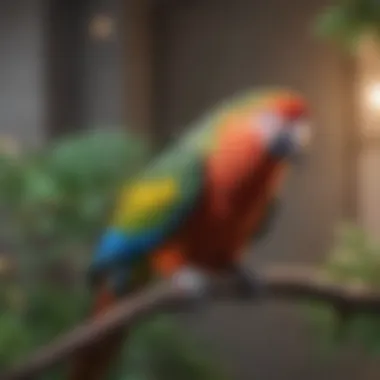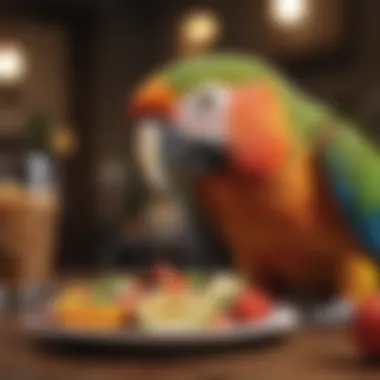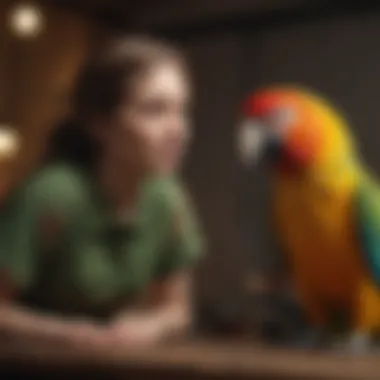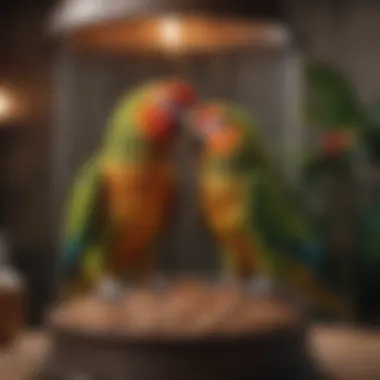Understanding Pet Parrots: Care and Companionship Guide


Intro
Pet parrots are remarkable companions that offer joy but need delicate care. Understanding these birds helps to evolve the bond between owner and pet. This article presents valuable insights into the specific requirements of these intelligent creatures.
Care Tips
Caring for parrots goes beyond providing food and water. It involves establishing daily routines, managing their living environment, and adjusting care according to changes in seasons.
Daily Care Routines
A structured daily care routine can foster stability for parrots. Regular activities include fresh food and water provision, engaging playtime, and ensuring they receive proper social interaction. Interaction can take the form of conversation, physical touch, or mental tasks that keep them entertained.
Cage Setup and Maintenance
Setting up a parrot's cage requires thoughtful placement of food, water, and toys. The cage should be spacious, with adequate room for flight and movement. Regular cleaning promotes a healthy environment. Removing waste and changing food and water daily is important to maintain hygiene. Making sure the area around the cage remains clean contributes to the parrot's overall well-being.
Hygiene and Cleaning Practices
Maintaining hygiene is vital in minimizing the risks of illness. Use bird-safe cleaning products. For a deeper clean, completely wash the cage every few weeks, including the toys.
Seasonal Care Adjustments
Parrots, like many living things, may require adjustments in their care due to seasonal variations. For example, in winter, ensure warmth and proper humidity levels. In summer, shade and water access become essential, as parakeets are sensitive to heat exposure.
Behavioral Insights
Understanding parrot behavior can enhance companionship, shed light on their emotional states, and address behavioral issues effectively.
Understanding Bird Body Language
Birds communicate predominantly through body language. Tail movements, head positioning, and vocalizations reveal emotions ranging from happiness to discomfort. Observing these signals can lead to more responsive care.
Common Behavioral Issues and Solutions
Like all pets, parrots can display behavioral issues, including excessive screaming or biting. Identifying these behaviors early allows for effective solutions which are often tied to environmental or social needs.
Positive Reinforcement Techniques
Utilizing positive reinforcement nurtures bond trust and encourages desired behaviors. Rewarding with treats, attention, or verbal praise fosters a learning environment that can help training become effective and enjoyable.
Social Interaction Needs
Parrots are inherently social. They flourish with regular interaction and can exhibit signs of distress when left alone for extended periods. Promoting social time can improve their mood and behavior significantly.
Nutrition Guides
Nutrition is paramount for the well-being of parrots. A proper diet not only supports physical health but can influence their behavior, kinship, and long-term health status.
Essential Diet Components
Parrots require a diverse dieta filled with seeds, pellets, fresh fruits, and vegetables. Each species may demand different dietary structures, adapting to the proper balance ensures optimal well-being.
Safe and Toxic Foods
While many fruits and veggies are safe, some are harmful. Avoid avocados, chocolate, and onion. Understanding which foods they can enjoy or harm is essential for responsible ownership.
Supplements and Treats
Alongside balanced nutrition, offering safe treats can enhance excitement during feeding times. However, offers must align with their everyday dietary needs, maintaining balance and health.
Feeding Strategies for Different Species
Different parrot species, such as African greys, budgerigars, and macaws, have varied nutritional needs. Researching those differences ensures owners provide appropriate nutrients staples.
Wellness and Health
Ensuring a parrot's health goes beyond nutrition. Routine veterinarian visits and keen observation of their behavior are the cornerstone of promoting wellness.
Routine Health Checkups
Consistent visits to an avian vet can prevent health issues from developing unnoticed. Checkups build a potential early identification system for health decline.
Identifying Symptoms of Illness


Awareness of subtle symptoms indicating illness can make a notable difference. Changes in appetite, energy levels, or social behavior is often the first clues showing an underlying problem.
Preventative Care and Vaccinations
Taking a proactive stance involves vaccinations as well as preventative medicine. This approach creates a favorable environment for stable survival and well-being dedicated preventive techniques.
Mental and Emotional Well-being
A parrot’s mental health forms an inseparable bond with physical health. Activities contributing to stimulation, such as interactive play, enhance every bird's emotional state.
Enriching Activities
A stimulating environment plays a crucial role in fostering your parrot's happiness, ensuring it avoids behavioral issues that stem from boredom.
Toys and Playtime Ideas
Providing very specific toys designed for birds provides an avenue for necessary interaction and exercise. Regularly alternating these helps maintain interest and increase engagement.
Training and Tricks
Teaching your parrot simple tricks encourages both verbal skills and bonding. Techniques like target training create both fun learning sessions and essential physical activity for overall health.
Outdoor Activities and Interaction
When safely supervised, outdoor activities immerse parrots into nature. Fresh air and new sights keep them mentally alert and encourage beneficial exercises like flying.
DIY Projects for Mental Stimulation
Crafting simple toys from household materials offers economical mental engagement opportunities. Surprises can emerge from varying techniques encouraging exploration and play at little expense.
Birds require both physical and mental needs catered for aiding their overall health.
Understanding these critical elements seeks to enhance both pet ownership and deeper companionship with these feathered beings. Always be open to learning new aspects, as being a good bird owner is a continuous journey.
Prolusion to Pet Parrots
When considering the inclusion of a pet into one’s life, parrots represent a unique blend of charisma, intelligence, and social nature. Understanding pet parrots is vital not only for their proper care but also for fostering a deep connection between the owner and the bird. These captivating creatures require specific considerations that set them apart from traditional pets such as cats or dogs. Parrots thrive in social environments and benefit from interactive relationships with their human caregivers. Successful ownership begins with comprehending the specific needs of these remarkable birds.
The Fascination with Parrots
Parrots have held the human interest for centuries, both in wild and captive environments. Their vibrant colors and ability to mimic human sounds contribute to their allure. The intelligence of parrots often exceeds that of many domesticated animals. They are capable of utilizing tools and solving puzzles. This enriching mental capacity offers countless opportunities for interaction.
Many people seek companionship from parrots as a means to enhance their own lives. Observing a parrot’s unique behaviors, such as hanging upside down or preening, can be fascinating. It often feels therapeutic to watch how parrots communicate and interact within their flock, be it in the wild or within a home setting.
Unlike many pets, noting these behaviors provides insight into the bird’s psychological health and happiness. A well-cared-for parrot can become a loyal and engaging companion.
Understanding Parrots as Pets
Parrots possess a rich array of traits that both challenge and charm potential caregivers. Recognizing their needs is crucial for successful ownership. Unlike other pets, parrots thrive on verbal communication and mental stimulation. It is essential to foster an environment where they can express their natural behaviors, including playing, climbing, and flying, if space allows.
Behavioral insights suggest that parrots can become attached to their owners, display affection, and learn to associate actions and cues with positive outcomes. However, these birds also experience emotions intensely. Stress or boredom can foster considerable behavioral problems, ranging from feather plucking to aggression. Thus, strong awareness of their emotional states is critical.
Educating oneself about different parrot species, requires careful thought. Some breeds are better suited for novice owners. Conversely, more exotic types could require experience. Aiming to present an optimal environment enhances the possibility of a satisfying relationship. By dovetailing an understanding of their social, emotional, and environmental needs, owners lay the groundwork for a meaningful partnership with their feathered friends.
Choosing the Right Parrot Species
Choosing the right parrot species is crucial for both prospective pet owners and current bird enthusiasts. Each species has its own unique characteristics, temperaments, and care requirements. Making an informed decision about which parrot to bring into your home can significantly influence your overall experience and the well-being of the bird.
Different species offer varying levels of social interaction, noise levels, and needs for physical space. Some parrots can develop strong bonds with their owners, while others may prefer a more independent lifestyle. Your choice should align with your living situation and how much time you are willing to devote to the bird’s care and socialization.
Understanding the specific demands each species presents is important as not all are suitable as pets for beginners. The considerations in choosing a parrot also affect the long-term relationship that can be formed, establishing a harmonious cohabitation. A mismatch regarding these factors can lead to frustrating situations for both the pet and the owner.
Popular Parrot Breeds for Pets
There are several popular parrot breeds that are commonly kept as pets. Each breed brings its own attributes and appeal.
1. Budgerigar (Budgie)
Budgerigars are small and widely regarded as one of the easiest parrots to care for. They are social and colorful, suitable for both beginners and experienced owners who want an active companion.
2. African Grey Parrot
Known for their intelligence and remarkable capacity for speech, African Grey Parrots require a lot of interaction and mental stimulation. They tend to form deep bonds but need dedicated attention for healthy development.
3. Cockatiel
Cockatiels are friendly and playful birds. They are charming companions, often engaging in playful antics but don’t require as much space as larger parrots.
4. Macaw
Macaws are large, stunning birds. Keeping a Macaw requires significant space and commitment. Their vibrant colors and playful nature endear them to many bird enthusiasts.
5. Amazon Parrot
Known for their playful demeanor and good talking ability, Amazon Parrots can be charming household companions. They are best suited to owners who can give ample time for socialization.


Knowing the particular needs, personality traits, and care requirements of these breeds allows pet owners to choose wisely to prevent behaviors that may lead to complications or unhappiness.
Assessing Your Lifestyle and Space
When choosing a parrot species, assessing your lifestyle and available space is key. Larger species often require more room for flying, play, and exercise as well as larger cages. Understanding how a parrot fits into your daily routine will set the tone for the relationship.
Evaluating a few aspects is useful:
- Time Commitment: Parrots are highly social and need daily interaction. If your day is busy, smaller birds like budgies may be a better choice.
- Physical Space: Larger birds need larger cage sizes and more space to fly. Assess the space you can allocate for proper housing and safe play areas.
- Noise Tolerance: Some birds, particularly larger and more vocal species, can be quite loud. Know your own tolerance for noise when choosing.
- Family Dynamics: Determine who in the household will interact with the bird. Some breeds may be better suited for families with children, while others thrive best in a quieter household.
- Lifestyle Changes: If fundamental changes to your lifestyle or living situation are anticipated, consider how a new parrot impacts those changes in the near future.
In analyzing all these factors, you assess not just your ability to physically care for a bird but also your readiness to engage with your feathered friend socially, mentally, and emotionally. Choosing the right parrot becomes a thoughtful blend of personal circumstances and the characteristics of each species.
Essential Care for Pet Parrots
Caring for pet parrots is not only vital for their health but also enriches the owner-bird relationship. Understanding the specific needs of these intelligent creatures ensures they thrive in a domestic environment. Proper care enhances the overall experience and fosters a bond between the bird and owner. Without appropriate care, parrots can face health issues, behavioral problems, and a diminished quality of life. This section delves into the essentials, including housing and cleaning practices that are crucial for the well-being of pet parrots.
Housing Requirements
Creating an appropriate habitat is fundamental for the physical and psychological health of a parrot. Housing plays a significant role in their comfort, safety, and happiness. Here are some key considerations:
- Cage Size: Choose a spacious cage, allowing ample movement and flight. Small cages may restrict movement, leading to stress.
- Bar Spacing: Ensure the bar spacing is suitable for the species. Small parrots need narrower spacing to prevent escapes.
- Material: Use non-toxic materials for cages. Stainless steel is a durable and safe option. Avoid painted or coated metal that can chip and release toxins.
- Location: Place the cage in a low-traffic area, away from direct sunlight or drafts. Parrots appreciate social environments but require personal space.
- Perches and Accessories: Include perches of different sizes and textures to promote foot health. Adding toys and enrichment items will create a stimulating habitat.
An environment tailored to their needs stimulates their natural behaviors and reduces boredom, ensuring a happy and healthy pet.
Cleaning and Maintenance
Regular cleaning and thoughtful maintenance are essential for retaining a safe environment for your parrot. Dirt and waste in the cage can lead to illness, while an unkempt habitat can trigger stress. Here are important practices to adopt:
- Daily Cleanup: Spot clean the cage every day to remove fresh droppings and uneaten food. This prevents odors and bacteria from accumulating.
- Deep Cleaning: Perform a thorough cleanse every week. Remove the parrot while you scrub the surfaces with soap and water. For tougher stains, a vinegar and water solution can be effective.
- Disinfecting Toys: Clean toys weekly with warm soapy water, ensuring all residue is eliminated. Avoid toxic cleaning agents that may harm your pet.
- Monitor Food and Water: Regularly check and refresh food and water dishes. Contaminated food can lead to health issues. Dirty water containers should be replaced rapidly.
Establishing a consistent cleaning schedule keeps your parrot's environment healthy. Parrots are sensitive by nature, so maintenance can foster a sense of security for these animals.
Regular cleaning ensures a safe, hygienic, and enjoyable atmosphere for your parrot, promoting their health and well-being.
Integrating these essential care practices provides a nurturing space where your pet parrot can flourish, enhancing their natural qualities which makes them cared and love. By applying the insights from this section, you solidify the foundation for a long-lasting companionship.
Nutrition and Diet
Nutrition is foundational to the well-being of pet parrots. The right diet ensures a healthy life, supports their immune system, and enhances their quality of life. A poorly balanced diet can lead to health issues like obesity, feather plucking, and even organ disorders. Parrots, being primarily seed-eaters in their natural habitat, require a more varied diet to thrive as pets. This article will delve into their basic dietary needs, offering guidance for selecting appropriate foods and safe treats.
Basic Dietary Needs
The dietary needs of parrots involve a combination of different food groups to create a balanced approach. Here are the main components:
- Pellets: Specially formulated pellets should form the basis of a parrot's diet. Unlike seeds, Balanced pellets are designed to meet the nutritional requirements. Aim to choose pellets that have a variety of ingredients to provide different nutrients.
- Fruits and Vegetables: Fresh produce should be included every day. Leafy greens, carrots, and fruits such as apples and bananas supply vitamins and minerals. Be cautious as some fruits might be high in sugar.
- Grains and Legumes: Cooked grains such as rice or quinoa and legume offerings like lentils can diversify their diet. These provide essential proteins and carbohydrates.
- Nuts and Seeds: These can be offered in moderation as a treat. Nuts are high in fat while seeds can contribute to obesity when overfed. Choose unsalted varieties to avoid excess sodium.
It’s crucial to adopt a variety in their diet to avoid the development of nutritional deficiencies or overloads. A shift in dietary habits can encourage interest in food and also offer mentally stimulating options.
Common Foods and Safe Treats
When planning a meal for your parrot, some foods can be nourishing while others can pose a risk. Familiarity with the safe and toxic foods is important:
Safe Options
- Apples (remove seeds)
- Carrots
- Broccoli
- Bell Peppers
- Spinach
- Pineapple
Moderation Treats
- Nuts: Almonds, walnuts, and pistachios should be limited due to high caloric content. Also important is
- Seeds: Various seeds can provide enrichment but they shouldn't dominate their diet.
Foods to Avoid
- Avocado: This food is toxic to parrots and can cause serious health issues.
- Chocolate: Always deadly to birds, make sure to keep it out of reach.
It is very important to consult with a veterinarian specializing in avian care to design a diet best suited for your specific bird’s needs. Ensuring a well-balanced diet promotes a vibrant and healthy parro.
Appropriate nutrition significantly influences your relationship with your bird. Observing them, as they enjoy an array of options helps enhance their mental health and fosters a stronger bond with you.
Behavioral Insights
Understanding the behavioral dynamics of pet parrots is crucial for achieving a harmonious living environment. Parrots are highly social and intelligent creatures, and comprehending their behaviors opens a door to building a strong relationship. This understanding can lead to effective communication, improved trust, and enhanced companionship between the bird and its owner. Behavioral insights also highlight how certain actions increase stress levels or boredom, which can lead to health issues. Knowing how to interpret these signals is essential in becoming a responsible parrot owner.
Understanding Parrot Communication
Parrots communicate in various ways, and this goes beyond vocalizations. They use body language and facial expressions significant to their messaging. Vocalizations can range from simple whistles to complex sounds, and each different sound can denote a feeling or need.


For example, a loud squawk might indicate excitement or the need for attention, while softer chirps may imply contentment. Observational attentiveness is key.
Pay particular attention to the following behaviors:
- Wing flapping: This can signal excitement or distress.
- Head bobbing: Displaying enthusiasm or urge to play.
- Tail fanning: A display of comfort or confidence.
In summary, being attuned to your parrot's communication fosters a stronger bond and mitigates miscommunication.
Recognizing Stress Signals
Recognizing stress signals in parrots is vital for their well-being. Stress can stem from numerous sources such as changes in environment, the presence of unfamiliar people, or even dietary issues. Common stress behaviors include feather plucking, excessive vocalization, and inactivity. These patterns signal an underlying issue that needs addressing.
Some warning signs to look out for:
- Droopy posture: Signals passive distress or lethargy.
- Avoiding touch: Can indicate discomfort or unwillingness to socialize.
- Change in eating habits: Loss of appetite or overeating signifies unease.
By identifying these signals promptly, one can take corrective actions to alleviate the discomfort and improve the parrot's quality of life.
Social Needs and Interaction
Parrots are inherently social animals and thrive in environments where they can engage with others. Ignoring their need for interaction can lead to various emotional and physical problems, such as loneliness or aggression. Regular socialization not only enhances their well-being but also builds their trust toward humans.
Engaging activities include:
- Dedicated playtime: Offering toys and companionship, avoiding isolation.
- Training sessions: Utilizing positive reinforcement can harness their intelligence and provide mental stimulation.
- Bird-safe companions: Introducing another bird (after careful considerations)
Meeting a parrot's social needs is important not only for their mental health, but also contributes to the deeper bond you will share, enriching your time together.
The essence of fulfilling a parrot's behavioral needs forms the backbone of responsible ownership, ultimately resulting in a more harmonious coexistence.
Health and Wellness
The health and wellness of pet parrots is a foundational aspect of responsible bird ownership. Ensuring that parrots maintain their health directly influences their quality of life, longevity, and overall behavior. Understanding how to care for a parrot involves recognizing key health indicators, knowing when to consult a veterinarian, and familiarizing oneself with the usual health requirements for these vibrant birds.
Good health in parrots results from proper care routines, mental stimulation, and a nutrient-rich diet. Establishing a comprehensive health plan allows for identifying problems before they escalate. A well-cared-for parrot is an active, engaging companion, which fosters a deeper bond between owner and bird. Let’s explore the two main aspects of parrot health: routine veterinary care and signs of illness.
Routine Veterinary Care
Routine veterinary check-ups are crucial for maintaining the health of pet parrots. Unlike dogs or cats, birds often disguise their discomfort or illness until it becomes critical. Therefore, regular examinations by an avian vet are essential.
Key components of routine care include:
- Annual check-ups: Regular visits help catch potential problems early on.
- Vaccinations: Protects parrots against serious diseases. Common vaccines include Polyomavirus and West Nile virus.
- Tests and screenings: Blood tests and fecal tests may be required to screen for asymptomatic infections.
- Grooming: Routine nail trimming and feather maintenance prevent physical injuries and discomfort.
Building a good relationship with a vet familiar with avian species is beneficial. They will provide personalized guidelines based on specific needs of the parrot species one owns.
Signs of Illness to Watch For
Identifying signs of illness in parrots is a critical responsibility for owners. It is often challenging since these creatures were evolutionarily wired to hide symptoms until it is too late.
Some common signs of illness include:
- Change in appetite: A sudden decrease in food and water intake can indicate distress.
- Abnormal droppings: Changes in color, texture, or frequency of droppings can signal illness.
- Fluffed feathers: While birds occasionally fluff up their feathers, persistent fluffing is often a sign of unease, stress, or illness.
- Behavior shifts: Be observant for signs of lethargy, increased aggression, or reduced vocalization, which all may indicate discomfort or pain.
Regular observation and the ability to articulate behavioral changes is crucial. Owners should note that early detection of these symptoms leads to quicker veterinary intervention, positively impacting recovery potential.
Enrichment Activities for Parrots
Enrichment activities are vital for pet parrots. These activities help simulate the complexities of their natural environments. In captivity, neglecting enrichment can lead to boredom, which often results in behavioral issues. Engaging activities can combat adverse effects of a monotonous environment. They stimulate a parrot's physical and mental capabilities.
Benefits of enrichment include:
- Preventing boredom: Bored parrots might develop destructive behaviors or excessive vocalization.
- Physical exercise: Activities can promote movement, keeping parrots in better shape psychologically and physically.
- Cognition: Challenging toys can stimulate their minds, reinforcing problem-solving skills.
Thus, developing a routine enrichment plan is essential for parrot health.
Interactive Toys and Playtime
Interactive toys play an essential role in keeping parrots entertained. Such toys often require parrots to work for rewards, mimicking foraging behavior found in the wild. Examples of interactive toys include:
- Puzzle feeders: These toys require the bird to figure out how to access food.
- Shreddable toys: Parrots can chew, tear, and dismantle, which helps in natural beak maintenance.
- Swinging or climbing toys: These kinds of toys provide physical exercise.
Selecting interactive toys
When choosing interactive toys, it is important to consider the bird’s size and species. Larger species may need sturdier toys compared to smaller species. It’s vital also to quickly rotate the toys, providing different experiences to keep stimulation high.
Chewing Materials:
- Corn husks
- Safe wood
- Paper















